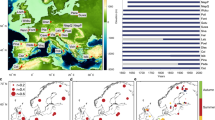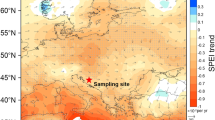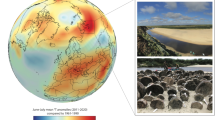Abstract
It is not known how global warming will affect the El Niño/Southern Oscillation (ENSO). The instrumental record is too short to discern centennial-scale trends and modelling results are inconclusive1,2,3,4,5. Proxy reconstructions indicate that ENSO activity was relatively high during the late twentieth century6,7,8,9,10, but whether this was unusual in the millennial context remains uncertain. Here we present insights into these issues derived from rings of the kauri tree (Agathis australis), a rare long-lived conifer endemic to the forests of northern New Zealand. Our results indicate that the twentieth century was the most ‘ENSO-active’ century of the past 500 years, but may not be unique in the context of the past 700 years, and that ENSO activity comparable to or elevated above that experienced during the late twentieth century is plausible under warmer-than-present conditions. We also find evidence that there may have been significant changes in the ENSO teleconnection to the New Zealand region during the fourteenth and fifteenth centuries, and of multi-decadal fluctuations in ENSO-related activity building up to the present day. Although these two features may delay the expression of increased ENSO activity in the New Zealand region, our results indicate that New Zealand climate is likely to be more dominated by ENSO-related inter-annual variability as the world continues to warm.
This is a preview of subscription content, access via your institution
Access options
Subscribe to this journal
Receive 12 print issues and online access
$209.00 per year
only $17.42 per issue
Buy this article
- Purchase on Springer Link
- Instant access to full article PDF
Prices may be subject to local taxes which are calculated during checkout



Similar content being viewed by others
References
Collins, M. et al. The impact of global warming on the tropical Pacific Ocean and El Niño. Nature Geosci. 3, 391–397 (2010).
Cane, M. A. The evolution of El Niño, past and future. Earth Planet. Sci. Lett. 230, 227–240 (2005).
van Oldenborgh, G. J., Philip, S. Y. & Collins, M. El Niño in a changing climate: A multi-model study. Ocean Sci. 1, 81–95 (2005).
Guilyardi, E. El Niño-mean state–seasonal cycles interactions in a multi-model ensemble. Clim. Dynam. 26, 329–348 (2006).
Guilyardi, E. Understanding El Niño in ocean-atmosphere general circulation models: Progress and challenges. Bull. Am. Meteorol. Soc. 90, 325–340 (2009).
Mann, M. E., Bradley, R. S. & Hughes, M. K. in El Niño and the Southern Oscillation: Multiscale Variability and Global and Regional Impacts (eds Diaz, H. F. & Markgraf, V.) 357–412 (Cambridge Univ. Press, 2000).
D’Arrigo, R., Cook, E. R., Wilson, R. J., Allan, R. & Mann, M. E. On the variability of ENSO over the past six centuries. Geophys. Res. Lett. 32, L03711 (2005).
Braganza, K., Gergis, J. L., Power, S. B., Risbey, J. S. & Fowler, A. M. A multiproxy index of the El Niño–Southern Oscillation, A.D. 1525–1982. J. Geophys. Res. 114, D05106 (2009).
Wilson, R. et al. Reconstructing ENSO: The influence of method, proxy data, climate forcing and teleconnections. J. Quat. Sci. 25, 62–78 (2010).
McGregor, S., Timmermann, A. & Timm, O. A unified proxy for ENSO and PDO variability since 1650. Clim. Past 6, 1–17 (2010).
McPhaden, M. J., Zebiak, S. E. & Glantz, M. H. ENSO as an integrating concept in earth science. Science 314, 1740–1745 (2006).
Bouma, M. J., Kovats, R. S., Goubet, S. A., Cox, J. St. H. & Haines, A. Global assessment of El Niño’s disaster burden. Lancet 350, 1435–1438 (1997).
Easterling, D. R., Meehl, G. A., Parmesan, C., Changnon, S. A., Karl, T. R. & Mearns, L. O. Climate extremes: Observations, modelling, and impacts. Science 289, 2068–2074 (2000).
Kao, H-Y. & Yu, J-Y. Contrasting Eastern-Pacific and Central-Pacific types of ENSO. J. Clim. 22, 615–632 (2009).
Trenberth, K. E. & Hoar, T. J. El Niño and climate change. Geophys. Res. Lett. 24, 3057–3060 (1997).
Mann, M. E. et al. Global signatures and dynamical origins of the Little Ice Age and medieval climate anomaly. Science 326, 1256–1260 (2009).
Cobb, K. M., Charles, C. D., Cheng, H. & Edwards, R. L. El Niño/Southern Oscillation and tropical Pacific climate during the last millennium. Nature 424, 271–276 (2003).
Hereid, K. A., Quinn, T. M., Taylor, F. W., Shen, C. C. & Banner, J. L. ENSO variability during the Little Ice Age from the perspective of a long coral record from the Western Pacific Warm Pool. Eos Trans. AGU (Fall Meeting Suppl.) 91 abstr. PP43B-1680 (2010).
Fowler, A., Lorrey, A. & Crossley, P. Seasonal growth characteristics of kauri. Tree-Ring Res. 61, 3–20 (2005).
Fowler, A., Palmer, J., Salinger, J. & Ogden, J. Dendroclimatic interpretation of tree-rings in Agathis australis (kauri): 2. Evidence of a significant relationship with ENSO. J. R. Soc. NZ 30, 277–292 (2000).
Fowler, A. M., Boswijk, G., Gergis, J. & Lorrey, A. ENSO history recorded in Agathis australis (kauri) tree rings. Part A: Kauri’s potential as an ENSO proxy. Int. J. Climatol. 28, 1–20 (2008).
Mullan, A. B. On the linearity and stability of Southern Oscillation-climate relationships for New Zealand. Int. J. Climatol. 15, 1365–1386 (1995).
Boswijk, G., Fowler, A., Lorrey, A., Palmer, J. & Ogden, J. Extension of the New Zealand kauri (Agathis australis) chronology to 1724 BC. Holocene 16, 188–199 (2006).
Fowler, A. M. ENSO history recorded in Agathis australis (kauri) tree rings. Part B: 423 years of ENSO robustness. Int. J. Climatol. 28, 21–35 (2008).
Torrence, C. & Compo, G.P. A practical guide to wavelet analysis. Bull. Am. Meteorol. Soc. 79, 61–78 (1998).
Li, J. et al. Interdecadal modulation of El Niño amplitude during the past millennium. Nature Clim. Change 1, 114–118 (2011).
Bard, E. & Rickaby, R. E. M. Migration of the subtropical front as a modulator of glacial climate. Nature 460, 380–384 (2009).
Lorrey, A. et al. Speleothem stable isotope records interpreted within a multi-proxy framework and implications for New Zealand palaeoclimate reconstruction. Quat. Int. 187, 52–75 (2008).
Briffa, K. & Jones, P. in Methods of Dendrochronology: Applications in the Environmental Sciences (eds Cook, E. & Kairiukstis, L.) 137–152 (Kluwer Academic, 1990).
Lyons, R. G. Understanding Digital Signal Processing (Addison-Wesley Longman, 1997).
Acknowledgements
Financial support for this research was provided by the New Zealand Foundation for Research, Science and Technology (FRST contract UOAX0714) and by the Royal Society of New Zealand (Marsden Fund grants UOA108 and UOA415). We thank the United Kingdom Meteorological Office, the Australian Bureau of Meteorology and NOAA for various public domain data sets, and P. Crossley for invaluable technical assistance. J.W. acknowledges financial support by the Swiss National Science Foundation (postdoctoral fellowship PBEZ2-118902). We thank M. Therrell for useful commentaries and suggestions.
Author information
Authors and Affiliations
Contributions
G.B. led the dendrochronology and was responsible for developing most of the archaeological data set. A.M.L., J.G., S.P.J.M., J.G.P. and J.W. contributed to one or both tree-ring data sets. A.M.L. and J.W. contributed to the kauri seasonal growth study work. M.P. provided pith meta-data for the near-pith truncation resampling experiment. A.M.F. undertook all analyses and wrote the paper (with input from G.B., A.M.L. and J.W.).
Corresponding author
Ethics declarations
Competing interests
The authors declare no competing financial interests.
Supplementary information
Supplementary Information
Supplementary Information (PDF 2133 kb)
Rights and permissions
About this article
Cite this article
Fowler, A., Boswijk, G., Lorrey, A. et al. Multi-centennial tree-ring record of ENSO-related activity in New Zealand. Nature Clim Change 2, 172–176 (2012). https://doi.org/10.1038/nclimate1374
Received:
Accepted:
Published:
Issue Date:
DOI: https://doi.org/10.1038/nclimate1374
This article is cited by
-
Palaeo-notch sediments as reliable proxy records for climate change and anthropogenic activities: a short review
Environmental Earth Sciences (2021)
-
Increased influence of ENSO on Antarctic temperature since the Industrial Era
Scientific Reports (2019)
-
Intraspecific variability may not compensate for increasing climatic volatility
Population Ecology (2018)
-
Super instrumental El Niño events recorded by a Porites coral from the South China Sea
Coral Reefs (2018)
-
Mixed signals in trends of variance in high-elevation tree ring chronologies
Journal of Mountain Science (2017)



